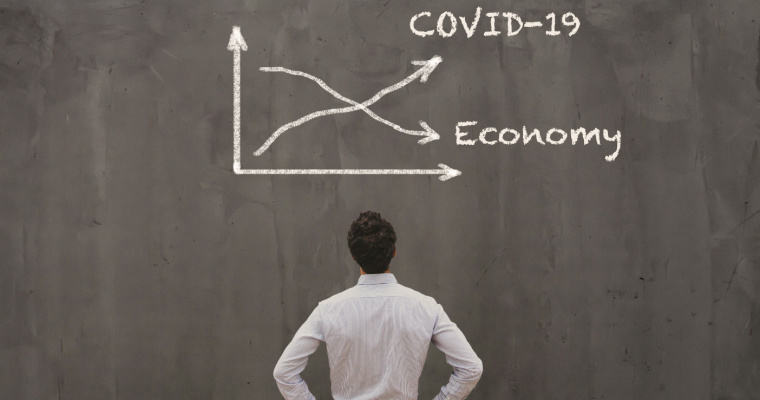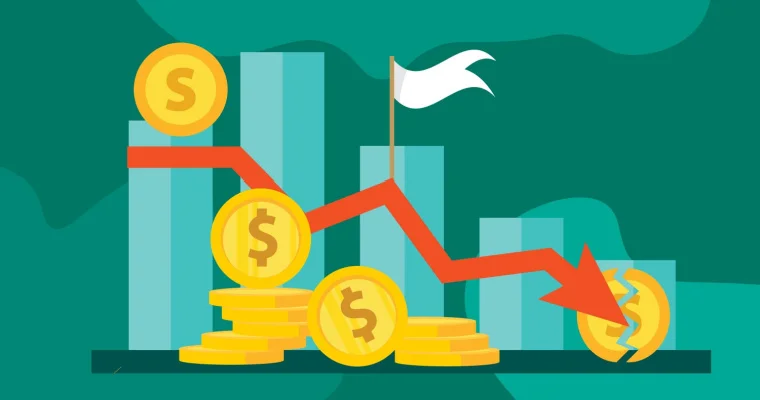What is V Shaped Recovery – Its Features and How is it Different From Others

It’s a term that’s used to describe a decline in the economy followed by a period of stark rise. This results in a V-shaped graphical representation of the situation. The first slope of the V shape shows a decline in the economy, while the following slope symbolises a quick recovery. The general analysis is based on several factors, such as recent economic trends, industrial manufacturing rates, Gross Domestic Product (GDP), and employment rates.
It is important to note that here the decline is steep, i.e. the fall is not gradual. The same is the case for recovery too. Typically, high inflation rates, job losses and more, followed by a quick overthrow, can result in a V-shaped recovery. This blog helps understand what a V-shaped recovery is, its features and how it affects investors. Read on!
V-shaped Recovery Meaning
V-shaped recovery is a graphical representation that provides an exact view of the economic decline during a short recession. The only factor separating a V-shaped recovery model from other types is the time taken for the economic activities to return to normalcy.
On the GDP graph, the left side of the letter ‘V’ represents the decline. The pit of the letter represents the maximum decline, while the right side represents a steep rise. Typically, steep declines can be a result of black-swan events like natural disasters, pandemics, and more. Such incidents can result in GPD fall, high employment etc. However, a V-shaped recovery can be noticed if an economy can overcome such circumstances quickly.
Take, for instance, the Covid-19 pandemic in the Indian context. In order to allow India to recover quickly, the Reserve Bank of India (RBI) kept their Repo and reverse repo rates unchanged at 4 and 3.35 %, respectively.
Now that we’ve understood how a V-shaped recovery structure functions, let us understand the key features that a V-shaped recovery can offer for an economy to get back on its feet.
Key Features of V-shaped Recovery
Here are some features that a V-shaped recovery:
- The name “V-shaped economy recovery” comes from its pictorial representation on a graph. The slopes of the graph are identical to the letter “V” representing recession and the rise of an economy.
- This type of recovery plan is seen when an economy goes through a state of “deep recession” and then goes on through a period of quick economic revival.
- To successfully initiate an economic revival, a Government may need to undertake several monetary measures. Typically, Central Banks are tasked with creating the perfect grounds for a V-shaped recovery.
- As the slope of the V starts to increase, an economy can be assumed to return to normalcy. Now, this can be through enhanced productivity, manufacturing and increased consumer demand.
Now that we’ve taken a look at the features of a v-shaped recovery plan, let’s go over the different types of recovery plans against a recession below;
Other Shapes of Economic Recovery
After a recession, an economic recovery takes several forms, shown in alphabetic representations through graphs. The main difference between these recovery patterns is the amount of time an economy takes to get back to normalcy.
In the following sections, let us understand the different shapes of economic recovery patterns.
1. U-shaped Recovery
This is a type of recession recovery pattern that can be noticed when the economy goes through a rapid decline in employment and GDP. Such a period of stagnation can create a u-shaped slump in the graph. It is similar to the V-shaped economy recovery except that a U-shaped recovery pattern indicates that the economy has taken more time to recover.
2. W-shaped Recovery
A W-shaped recovery pattern is famous for representing cycles of recession and recovery, which results in the formation of the letter ‘W.’
A W-shaped recovery pattern typically starts with a massive decline in GDP followed by a full recovery. The economy declines a second time, and so does the graph, ending with a rise to the initial position.
The formation of W can be a sign of stress, indicating instability in the economy.
3. L-shaped Recovery
This type of economic recovery pattern is seen when the economy plummets into a state of critical depression, with severe rates of unemployment and no economic growth. When these economic activities are plotted in a graph, the recovery pattern may look like the letter ‘L.’
4. Z-shaped Recovery
Under this type of recovery pattern, the economy quickly recovers after a short crash. This is the most positive recovery scenario for the economy. The depression period is usually very short.
How is V-shaped Recovery is Different From Others?
As discussed above, the kind of recovery an economy makes can result in different graphical representations. The fundamental difference is typically how quickly an economy recovers.
For instance, a V-shaped recovery is indicative of a quick fall and recovery, whereas a U-shaped recovery pattern points towards a slower recovery rate. Z-shaped recovery is closer to V-shaped recovery in the sense that the former is indicative of quicker recovery, just as the latter. Also, two very close V-shaped recoveries can be read as a ‘W’ recovery.
How Does V-shaped Recovery Affect the Investors?
A common trend during a recession is stock plummeting. Additionally, there can be drop-in FII inflows too. Other investors may also pull out of the economy, looking to invest in better-performing economies.
However, this changes when the markets/ economy has a V-shaped recovery, with consumers spending more, stock markets recovering, and companies increasing production/ adding jobs.
Final Words
A V-shaped recovery is an indicator of a quick economic rebound after a steep decline. There are other shaped recoveries, too, based on the time period of revival. Across decades, major economies have experienced different kinds of slumps and recoveries. V-shaped recovery of the economy was witnessed by many countries post-pandemic. Understand the different styles of recovery to understand economic movement better.
FAQs
Ans: The different types of economic recovery patterns are Z-shaped, U-shaped recovery, L-shaped, V-shaped, K-shaped and W-shaped.
Ans: The Government of India can come up with flexible monetary policies to balance the market.
Ans: This is a peculiar economic recovery scenario where certain industries remain fine during a recession, whereas others struggle.
Ans: Due to an efficient vaccination drive and robust growth in investment and consumption and investment, experts observe that the Indian economy is showing a v-shaped economic recovery from the pandemic.
Ans: With massive improvements in economic activity during the recovery, investments tend to perform better, positively impacting investors.
Disclaimer
This article is solely for educational purposes. Navi doesn't take any responsibility for the information or claims made in the blog.

Customer’s Feedback
No comments found.What is the Full Form of MGNREGS – Eligibility and How to Apply?
MGNREGS Full Form The full form of MGNREGS is Mahatma Gandhi National Rural Employment Guarantee... Read More »What is Primary Deficit? – Example, Formula & Measures
What is a Primary Deficit? Primary Deficit is the difference between the current year’s fiscal... Read More »TPA in Health Insurance – Meaning, Full Form, Functions and Roles
TPA (full form - Third Party Administrator) is a licensed intermediary between health insurance pol... Read More »5 Best Cancer Insurance Policy in India 2023 – Types and Benefits
Cancer insurance plans can give individuals and families financial protection from expensive cancer... Read More »10 Best Cashless Health Insurance Policy in India 2023 – Taxation and Cover
Cashless health insurance plans are policies that provide medical coverage to policyholders without... Read More »6 Best Critical Illness Insurance Companies in India 2023
Critical illness insurance is a type of health insurance policy that protects against fatal illness... Read More »10 Best Personal Accident Insurance Policy in India 2023
Accident insurance plans provide financial assistance to the policyholder in the event of an unfort... Read More »Best Health Insurance for Parents in India 2023 and How to Buy?
Health insurance for parents offer several perks, including a higher insured sum and full coverage ... Read More »Best Dental Insurance Plans in India 2023: Benefits, Types and How to Claim?
Dental insurance plans are policies that provide cover for expenses arising out of standard dental ... Read More »7 Best Health Insurance for Newborn in India 2023 – Benefits and Cover
Health insurance for newborns are crucial in today’s time. When you are a new parent, the safety ... Read More »Yeshasvini Health Insurance Scheme: Apply for Yeshasvini Health Card Online
Everyone should have access to quality, affordable healthcare. Yeshasvini Health Insurance Scheme i... Read More »5 Best Diabetes Health Insurance in India 2023 – Top Plans, Cover and Benefits Offered
Diabetes Health Insurance plans are specifically designed insurance covers for people who have diab... Read More »Top 10 Chit Fund Schemes in India in 2023
Chit funds are one of the most popular return-generating saving schemes in India. It is a financial... Read More »10 Best Gold ETFs in India to Invest in April 2023
Gold ETFs or Gold Exchange Traded Funds are passively managed funds that track the price of physica... Read More »10 Best Demat Accounts in India for Beginners in 2023
Creation of Demat accounts revolutionised the way trades were conducted at the stock exchanges. It... Read More »20 Best Index Funds to Invest in India in April 2023
What is an Index Fund? An index fund is a type of mutual fund or exchange-traded fund (ETF) that... Read More »Best Arbitrage Mutual Funds to Invest in India in April 2023
Arbitrage funds are hybrid mutual fund schemes that aim to make low-risk profits by buying and sell... Read More »10 Best SIP Plans in India to Invest in April 2023
What is SIP? SIP or Systematic Investment Plan is a method of investing a fixed amount in ... Read More »10 Best Corporate Bond Funds in India to Invest in April 2023
Corporate bond funds are debt funds that invest at least 80% of the investment corpus in companies ... Read More »10 Best Bank for Savings Account in India [Highest Interest Rate 2023]
Savings account is a type of financial instrument offered by several banks. It lets you safely depo... Read More »






























